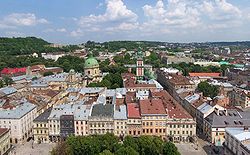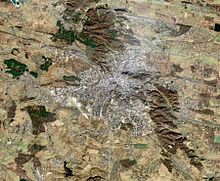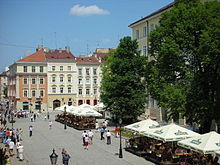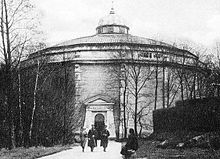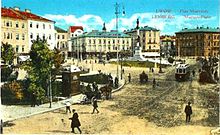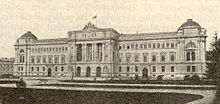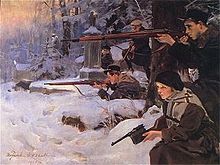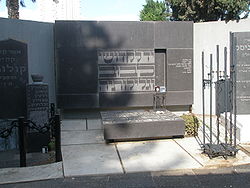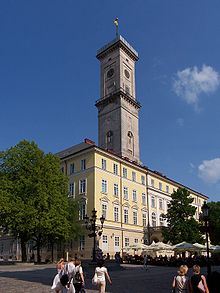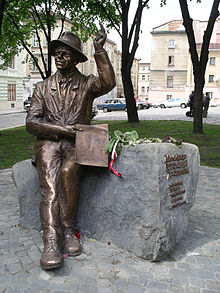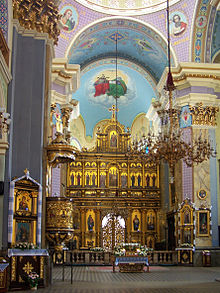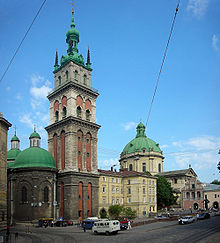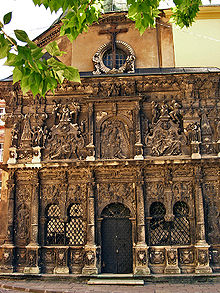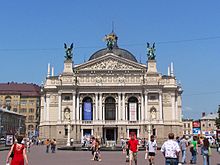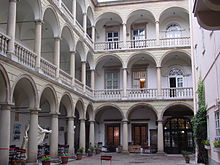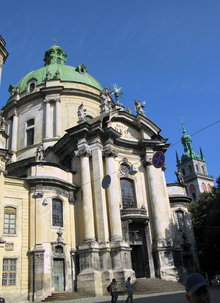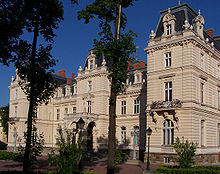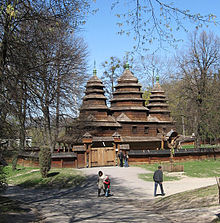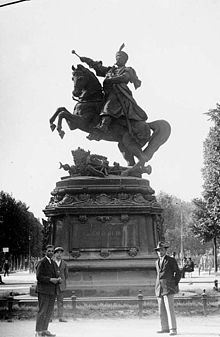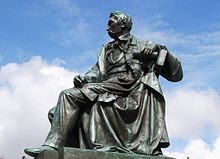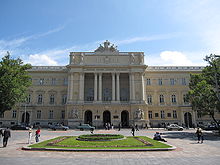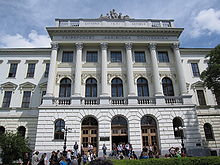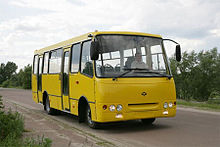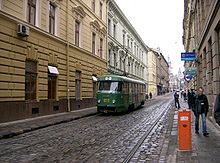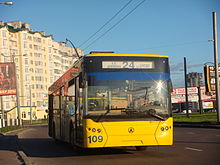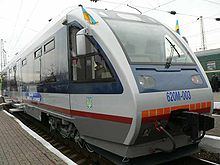- Lviv
-
"Lwów", "Lvov", and "Lemberg" redirect here. For other uses, see Lwów (ship), Lvov (disambiguation), and Lemberg (disambiguation).
Lviv
ЛьвівView of the historic Old Town of Lviv. 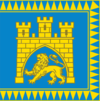
Flag
Coat of arms
LogoMotto: "Semper fidelis" Map of Ukraine (blue) with Lviv (red) highlighted. Coordinates: 49°51′0″N 24°01′0″E / 49.85°N 24.016667°ECoordinates: 49°51′0″N 24°01′0″E / 49.85°N 24.016667°E Country  Ukraine
UkraineOblast  Lviv Oblast
Lviv OblastRaion Lviv City Municipality Founded 13th century Magdeburg law 1353 Government – City Chairman Andriy Sadovyi Area – City 182.01 km2 (70.3 sq mi) Elevation 296 m (971 ft) Population (2010) – City 760,000 – Density 4,298/km2 (11,131.8/sq mi) – Metro 1,498,000 Time zone EET (UTC+2) – Summer (DST) EEST (UTC+3) Postal code 79000 Area code(s) +380 32(2) Licence plate BC (before 2004: ТА,ТВ,ТН,ТС) Sister cities Corning, Freiburg, Grozny, Kraków, Novi Sad, Przemyśl, Saint Petersburg, Whitstable, Winnipeg, Rochdale Website http://lviv.travel/en/index (English)
http://www.city-adm.lviv.ua (Ukrainian)Lviv (Ukrainian: Львів L’viv, IPA: [lʲwiu̯] (
 listen); Polish: Lwów; Russian: Львов, L'vov; German: Lemberg; Latin: Leopolis; see also other names) is a city in western Ukraine. The city is regarded as one of the main cultural centres of today's Ukraine and historically has also been a major Polish and Jewish cultural center, as Poles and Jews were the two main ethnicities of the city until the outbreak of World War II and the following Holocaust and Polish population transfers (1944–1946). The historical heart of Lviv with its old buildings and cobblestone roads has survived World War II and ensuing Soviet presence largely unscathed. The city has many industries and institutions of higher education such as the Lviv University and the Lviv Polytechnic. Lviv is also a home to many world-class cultural institutions, including a philharmonic orchestra and the famous Lviv Theatre of Opera and Ballet. The historic city centre is on the UNESCO World Heritage List. Lviv celebrated its 750th anniversary with a son et lumière in the city centre in September 2006.
listen); Polish: Lwów; Russian: Львов, L'vov; German: Lemberg; Latin: Leopolis; see also other names) is a city in western Ukraine. The city is regarded as one of the main cultural centres of today's Ukraine and historically has also been a major Polish and Jewish cultural center, as Poles and Jews were the two main ethnicities of the city until the outbreak of World War II and the following Holocaust and Polish population transfers (1944–1946). The historical heart of Lviv with its old buildings and cobblestone roads has survived World War II and ensuing Soviet presence largely unscathed. The city has many industries and institutions of higher education such as the Lviv University and the Lviv Polytechnic. Lviv is also a home to many world-class cultural institutions, including a philharmonic orchestra and the famous Lviv Theatre of Opera and Ballet. The historic city centre is on the UNESCO World Heritage List. Lviv celebrated its 750th anniversary with a son et lumière in the city centre in September 2006.Lviv was founded in 1256 in Red Ruthenia by King Danylo Halytskyi of the Ruthenian principality of Halych-Volhynia, and named in honour of his son, Lev. Together with the rest of Red Ruthenia, Lviv was captured by the Kingdom of Poland in 1349 during the reign of Polish king Casimir III the Great. Lviv belonged to the Crown of the Kingdom of Poland 1349–1772, the Austrian Empire 1772–1918 and the Second Polish Republic 1918–1939. With the Invasion of Poland at the outbreak of the second World War, the city of Lviv with adjacent land were annexed and incorporated into the Soviet Union, becoming part of the Ukrainian Soviet Socialist Republic from 1939 to 1941. Between July 1941 and July 1944 Lviv was under German occupation and was located in the General Government. In July 1944 it was captured by the Soviet Red Army and the Polish Home Army. According to the agreements of the Yalta Conference, Lviv was again integrated into the Ukrainian SSR. Most of the Poles living in Lviv were resettled into Polish territories annexed from Germany.
After the collapse of the Soviet Union in 1991, the city remained a part of the now independent Ukraine, for which it currently serves as the administrative centre of Lviv Oblast, and is designated as its own raion (district) within that oblast.
On 12 June 2009 the Ukrainian magazine Focus assessed Lviv as the best Ukrainian city to live in.[1] Its more Western European flavor lends it the nickname the "Little Paris of Ukraine".
The city is expecting a sharp increase in the number of foreign visitors next summer for the 2012 UEFA European Football Championship, and as a result a major new airport terminal is being built. Lviv is one of 8 Polish and Ukrainian cities that is co-hosting the group stages of the tournament.
Contents
Geography
Location
Lviv is located on the edge of the Roztochia Upland, approximately 70 km from the Polish border and 160 km (99 mi) from the eastern Carpathian Mountains. The average altitude of Lviv is 296 m (971.13 ft) above sea level. Its highest point is the Vysokyi Zamok (High Castle), 409 m (1,341.86 ft) above sea level. This castle has a commanding view of the historic city centre with its distinctive green-domed churches and intricate architecture.
The old walled city was at the foothills of the High Castle on the banks of the river Poltva. In the 13th century, the river was used to transport goods. In the early 20th century, the Poltva was covered over in areas where it flows through the city. The river flows directly beneath the central street of Lviv, Freedom Avenue (Prospect Svobody) and the renowned Lviv Opera House.
Climate
Lviv's climate is humid continental (Köppen climate classification Dfb). The average temperatures are −4 °C (25 °F) in January and 18 °C (64 °F) in June.[citation needed] Average annual rainfall is 760 mm (26 inches) with the maximum being in summer.[citation needed] Cloud coverage averages 266 days per year.[citation needed]
History
Pre-history
Archeologists have demonstrated that the Lviv area was settled by the 5th century.[2] From the ninth century in the area of present-day Lviv, between Castle Hill and the river Poltva, there existed a Lendian settlement – in the tenth century the Lendians established a fortified settlement on Castle Hill.[3] In 1977 it was discovered that the Orthodox church of St. Nicholas had been built on a previously functioning cemetery.[4] In 981, the Cherven Towns area was captured by Vladimir I and fell under the rule of Kievan Rus.
Halych-Volyn Principality
Lviv was founded by King Daniel of Galicia in the Ruthenian principality of Halych-Volhynia and named in honour of his son Lev.[5]
In 1261 the town was invaded by the Tatars.[6] Various sources relate the events which range from destruction of the castle through to a complete razing of the town. All the sources agree that it was on the orders of the Mongol general Burundai. The Naukove tovarystvo im. Shevchenka of the Shevchenko Scientific Society say that the order to raze the city was reduced by Burundai as the Galician-Volhynian chronicle states that in 1261 "Said Buronda to Vasylko: 'Since you are at peace with me then raze all your castles'".[7] Basil Dmytryshyn states that the order was implied to be the fortifications as a whole "If you wish to have peace with me, then destroy [all fortifications of] your towns".[8] According to the Universal-Lexicon der Gegenwart und Vergangenheit the town's founder was ordered to destroy the town himself.[9]
After Daniel's death Lev rebuilt the town around the year 1270 at its present location, choosing Lviv as his residence,[6] and made Lviv the capital of Galicia-Volhynia.[10] The city is first mentioned in the Halych-Volhynian Chronicle which dates from 1256. The town grew quickly due to an influx of Polish people from Kraków, Poland, after they had suffered a widespread famine there.[9] Around 1280 many Armenians lived in Galicia and were mainly based in Lviv where they had their own Archbishop.[11] The town was inherited by the Grand Duchy of Lithuania in 1340 and ruled by voivode Dmitri Detko, the favourite of the Lithuanian prince Lubart, until 1349.[12]
Galicia–Volhynia Wars
During the wars over the succession of Galicia-Volhynia Principality in 1339 King Casimir III of Poland undertook an expedition and conquered Lviv in 1340, burning down the old princely castle.[6] Poland ultimately gained control over Lviv and the adjacent region in 1349. From then on the population was subjected to attempts to both Polonize and Catholicize the population.[13]
Casimir built two new castles.[6] In 1356 he brought in German colonists and within 7 years granted the Magdeburg rights which implied that all city matters were to be resolved by a council elected by the wealthy citizens. The city council seal of the 14th century stated: S(igillum): Civitatis Lembvrgensis.
After Casimir had died in 1370, he was succeeded as king of Poland by his nephew, King Louis I of Hungary, who in 1372 put Lviv together with the region of Galicia-Volhynia under the administration of his relative Władysław, Duke of Opole.[6] When in 1387 Władysław retreated from the post of its governor, Galicia-Volhynia became occupied by the Hungarians, but soon Jadwiga, the youngest daughter of Louis, but also ruler of Poland and wife of King of Poland Władysław II Jagiełło, unified it directly with the Crown of the Kingdom of Poland.[6]
Kingdom of Poland
As part of the Crown of the Kingdom of Poland Lwów (Lviv) became the capital of the Ruthenian Voivodeship founded in 1389. The city's prosperity during the following centuries is owed to the trade privileges granted to it by Casimir, Jadwiga and the subsequent Polish kings.[6]
In 1412 the city became the seat of the Roman Catholic Archdiocese, which since 1375 had been in Halych.[6] In 1444 Lviv was granted with the staple right, which resulted in city's growing prosperity and wealth, as it became one of major trading centers on the merchant routes between Central Europe and Black Sea region. It was also transformed into a one of main fortresses in the kingdom.
As Lviv prospered it became religiously and ethnically diverse with Germans, Poles, Ruthenians, Armenians and Jews being the most important nationalities living within the city. With passing time most of them had assimilated to the dominant Polish culture and became polonized.
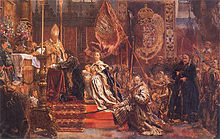 A painting by Jan Matejko of King Jan Kazimierz of Poland pledging his famous oath in L'viv's Latin Cathedral.
A painting by Jan Matejko of King Jan Kazimierz of Poland pledging his famous oath in L'viv's Latin Cathedral.
In 1572 the first publisher of books in Ukraine, Ivan Fedorovych, a graduate of the University of Kraków, settled in Lviv for a brief period when he was chased out of Moscow. The city became a significant centre for Eastern orthodoxy with the establishment of an orthodox brotherhood, a Greek-Slavonic school and a printery which published the first full versions of the Bible in Church Slavonic in 1580.
The 17th century brought invading armies of Swedes, Hungarians,[14][15] Turks,[16][17] Russians and Cossacks[15] to its gates. In 1648 a Ukrainian freedom fighting army of Cossacks and Crimean Tatars besieged Lviv. The city was not sacked due to its beauty and the leader of the revolution Bohdan Khmelnytsky studied there as well and did not want to see it ruined. As a result a ransom of 250 000 ducat was paid and the Cossacks marched west towards Zamostia. Lviv was the only major city in Poland which was not captured by the invaders. In 1672 it was surrounded by the Ottomans who failed to conquer it. Lviv was captured for the first time by a foreign army in 1704 when Swedish troops under King Charles XII entered the city after a short siege.
Habsburg Empire
In 1772, following the First Partition of Poland, the region was annexed by Austria. Known in German as Lemberg, the city became the capital of the Kingdom of Galicia and Lodomeria. The city grew dramatically under Austrian rule, increasing in population from approximately 30,000 at the time of Austrian annexation in 1772[18] to 206,100 by 1910.[19] In 1773, the first newspaper in Lviv, Gazette de Leopoli, began to be published. In 1784, a German language University was opened; after closing again in 1805, it was re-opened in 1817.
In the 19th century, the Austrian administration attempted to Germanise the city's educational and governmental functioning. Many cultural organizations which did not have a pro-German orientation were closed. After the revolution of 1848, the language of instruction at the University shifted from German to include Ukrainian and Polish. Around that time, a certain sociolect developed in the city known as the Lwów dialect. Considered to be a type of Polish dialect, it draws its roots from numerous other languages besides Polish.
In 1853, it was the first European city to have street lights due to innovations discovered by Lviv inhabitants Ignacy Łukasiewicz and Jan Zeh. In that year kerosene lamps were introduced as street lights which in 1858 were updated to gas and in 1900 to electricity.
After the so-called Ausgleich of February 1867, the Austrian Empire was reformed into a dualist Austria-Hungary and a slow yet steady process of liberalisation of Austrian rule in Galicia started. From 1873, Galicia was de facto an autonomous province of Austria-Hungary with Polish and, to a much lesser degree, Ukrainian or Ruthenian, as official languages. The Germanisation had been halted and the censorship lifted as well. Galicia was subject to the Austrian part of the Dual Monarchy, but the Galician Sejm and provincial administration, both established in Lviv, had extensive privileges and prerogatives, especially in education, culture, and local affairs. The city started to grow rapidly, becoming the 4th largest in Austria-Hungary, according to the census of 1910. Many Belle Époque public edifices and tenement houses were erected, the buildings from the Austrian period, such as the opera theater built in the Viennese neo-Renaissance style, still dominate and characterize much of the centre of the city.
During Habsburg rule, Lviv became one of the most important Polish, Ukrainian and Jewish cultural centers. In Lviv, according to the Austrian census of 1910, which listed religion and language, 51% of the city's population were Roman Catholics, 28% Jews, and 19% belonged to the Ukrainian Greek Catholic Church. Linguistically, 86% of the city's population used the Polish language and 11% preferred the Ukrainian language.[19] Lviv was home to the Polish Ossolineum, with the second largest collection of Polish books in the world, the Polish Academy of Arts, the Polish Historical Society, the Polish Theater and Polish Archdiocese. At the same time, the city also housed the largest and most influential Ukrainian institutions in the world, including the Prosvita society dedicated to spreading literacy in the Ukrainian language, the Shevchenko Scientific Society, the Dniester Insurance Company and base of the Ukrainian cooperative movement, and it served as the seat of the Ukrainian Catholic Church. Lviv was also a major center of Jewish culture, in particular as a center of the Yiddish language, and was the home of the world's first Yiddish-language daily newspaper, the Lemberger Togblat, established in 1904.[20]
In the early stage of World War I, Lviv was captured by the Russian army in September 1914 but retaken by Austria–Hungary in June the following year.
Polish-Ukrainian War
Further information: Polish-Ukrainian WarAfter the collapse of the Habsburg Monarchy at the end of World War I Lviv became an arena of battle between the local Polish population and the Ukrainian Sich Riflemen. Both nations perceived the city as integral part of their new statehoods which at that time were forming in the former Austrian territories. On the night of 31 October – 1 November 1918 the Western Ukrainian National Republic was proclaimed with Lviv as its capital. 2,300 Ukrainian soldiers from the Ukrainian Sich Riflemen (Sichovi Striltsi), which had previously been a corps in the Austrian Army, took control over Lviv. The city's Polish majority opposed the Ukrainian declaration and began to fight against the Ukrainian troops.[21] During this combat an important role was taken by young Polish city defenders called Lwów Eaglets. For the courage of its inhabitants Lviv was awarded the Virtuti Militari cross by Józef Piłsudski on 22 November 1920.
The Ukrainian forces withdrew outside Lviv's confines by 21 November 1918, after which elements of Polish soldiery begun to loot and burn much of the Jewish and Ukrainian quarters of the city, killing approximately 340 civilians (see: Lwów pogrom (1918)).[22] The retreating Ukrainian forces besieged the city. The Sich riflemen reformed into the Ukrainian Galician Army (UHA). The Polish forces aided from central Poland, including general Haller's Blue Army, equipped by the French, relieved the besieged city in May 1919 forcing the UHA to the east. Despite Entente mediation attempts to cease hostilities and reach a compromise between belligerents the Polish–Ukrainian War continued until July 1919 when the last UHA forces withdrew east of the river Zbruch. The border on the river Zbruch was confirmed at the Treaty of Warsaw, when in April 1920 Polish government signed an agreement with Symon Petlura where it was agreed that for military support against the Bolsheviks the Ukrainian People's Republic renounced its claims to the territories of Eastern Galicia.
In August 1920 Lviv was attacked by the Red Army under the command of Aleksandr Yegorov and Stalin during Polish-Soviet War but the city repelled the attack.[23]
Polish sovereignty over Lviv was internationally recognised when the Council of Ambassadors ultimately approved it in March 1923.
Second Polish Republic
Main languages of Lviv
from the census of 1931[24]Polish 198,212 (63.5%) Yiddish 75,316 (24.1%) Ukrainian 24,245 (7.8%) Ruthenian 10,892 (3.5%) Other 3,566 (1.1%) Total 312,231 Note: In the table above Ruthenian nationality stands
for Ruthenians who did not adopt the Ukrainian
ethnic identity in the early 20th century
and Lemkos, Boykos, Hutsuls and Rusyns.In the interbellum period Lviv held the rank of Poland's third most populous city (after Warsaw and Łódź) and became the seat of the Lwów Voivodeship. Right after Warsaw, it was the second most important cultural and academic centre of interwar Poland. In the academic year 1937–38 there were 9,100 students attending 5 higher education facilities including the renowned university and institute of technology.[25] In 1920 professor Rudolf Weigl of the Lwów University discovered the vaccine against typhus. The major trade fair called Targi Wschodnie was established 1921. Its geographic location gave it an important role in stimulating international trade and fostering city's and Poland's economic development.
While the eastern part of the Lwów Voivodeship had a relative Ukrainian majority in most of the rural areas the city itself did not (see table to the right). Prewar Lviv had also a large and thriving Jewish population. The Polish inhabitants of the city spoke the characteristic Lwów dialect.
Although Polish authorities obliged themselves internationally to provide Eastern Galicia with an autonomy (including a creation of a separate Ukrainian university in Lviv) and even though in September 1922 adequate Polish Sejm's Bill[26] was enacted, it was not fulfilled. Instead, the Polish government closed down many Ukrainian schools that had previously flourished during Austrian rule[27] and closed down every Ukrainian university department at the University of Lviv with the exception of one.[28] Unlike in Austrian times, when the size and amount of public parades or other cultural expressions corresponded to each cultural group's relative population, the Polish government emphasized the Polish nature of the city and limited public displays of Jewish and Ukrainian culture. Military parades and commemorations of battles at particular streets within the city, all celebrating the Polish forces who fought against the Ukrainians in 1918, became frequent, and in the 1930s a vast memorial monument and burial ground of Polish soldiers from that conflict was built in the city's Lychakiv Cemetery. The Polish government fostered the idea of Lviv as an eastern Polish outpost standing strong against eastern "hordes."[29]
World War II and Soviet occupation
Following the signing of the Molotov-Ribbentrop Pact Germany invaded Poland on 1 September 1939 and by 14 September Lviv was completely encircled by German units.[30] Subsequently the Soviets invaded Poland on 17 September. The Soviet Union annexed the eastern part of Second Polish Republic including the city of Lviv which capitulated to the Red Army on 22 September 1939.
The city (named Lvov in Russian) became the capital of the newly formed Lviv Oblast. The Soviets opened many Ukrainian-language schools that had been closed by the Polish government[31] and Ukrainian was reintroduced in the University of Lviv (where the Polish government had banished it during the interwar years), which became thoroughly Ukrainized and renamed after Ukrainian writer Ivan Franko.[32]
The Soviets also started repressions against local Poles and Ukrainians deporting many of the citizens. Waves of deportations started with the Poles followed by the Jews who had refused Soviet passports and then the Ukrainian nationalists.
Nazi occupation
On 22 June 1941, Nazi Germany and several of its allies invaded the USSR.
In the initial stage of Operation Barbarossa (late June 1941) Lviv was taken by the Germans. The evacuating Soviets killed most of the prison population. Wehrmacht forces arriving in the city discovered evidence of the Soviet mass murders[33] committed by the NKVD and NKGB. Ukrainian nationalists, organized as a militia, and the civilian population were allowed to take revenge on the "Jews and the Bolsheviks" and indulged in several mass killings in Lviv and the surrounding region, which resulted in the deaths estimated at between 4,000 and 10,000 Jews (see: Lviv pogroms). The Germans during the occupation of the city committed numerous other atrocities including the "killing of Polish university professors".
On 30 June 1941 Yaroslav Stetsko proclaimed in Lviv the Government of an independent Ukrainian state allied with Nazi Germany. This was done without pre-approval from the Germans and after 15 September 1941 the organisers were arrested.[34][35][36]
The Sikorski–Mayski Agreement signed in London on 30 July 1941 between Polish government-in-exile and USSR's government invalidated the September 1939 Soviet-German partition of Poland, as the Soviets declared it null and void.[37]
Meanwhile German-occupied Eastern Galicia at the beginning of August 1941 was incorporated into the General Government as Distrikt Galizien with Lviv as district's capital.
Germany viewed Galicia, formerly Austrian crown land, as already aryanised and civilised. As a result the Ukrainian Galicians escaped the full extent of German acts in comparison to Ukrainians who lived in Ukraine.[38] German policy towards the Polish population in this area was more harsh and comparable to the situation in the rest of the General Government. According to the Third Reich's racial policies Galician Jews became the main target of German repressions. Almost all of the Jewish Galicians were deported to concentration camps or killed. In 1941 there were approximately 200,000 Jews in Lviv.[39] By the end of the war the Jewish population was virtually wiped out with only 200 to 300 Jews left alive.[40]
Soviet re-occupation
The Soviet 3rd Tank Army entered Lviv again after the Lvov–Sandomierz Offensive of 22–24 July 1944. After the city was taken by cooperating Soviet forces and local resistance soldiers of Armia Krajowa (see: Lwów Uprising), the local commanders of the Polish AK were invited to a meeting with the commanders of the Red Army where they were arrested by the NKVD.
In January 1945 the local NKVD arrested many Poles in Lviv where, according to Soviet sources, on 1 October 1944 Poles still made a clear majority – 66.7% of the population, to encourage their emigration from their city. Those arrested were released after they signed papers agreeing to emigrate to Poland which postwar borders were moved westwards with Lviv left within the borders of the Soviet Union, according to the Yalta conference settlements.
It is estimated that from 100,000 to 140,000 Poles were resettled from the city into the so called Recovered Territories as a part of postwar population transfers, many of them to the area of newly acquired Wrocław, formerly the German Breslau. Little remains of Polish culture in Lviv except for the Italian-influenced architecture.[41] The Polish history of Lviv is still well remembered in Poland and those Poles who stayed in Lviv have formed their own organisation the Association of Polish Culture of the Lviv Land.
Lviv and its population suffered greatly during the two world wars as many of the offensives were fought across the local geography causing significant collateral damage and disruption.
On 16 August 1945, a border agreement[42] between the government of the Soviet Union and the Provisional Government of National Unity, installed by the Soviets, was signed in Moscow. In that treaty, Poland formally ceded its prewar eastern part to the Soviet Union agreeing to the Polish-Soviet border drawn according to the so called Curzon Line. Consequently, the agreement was ratified on 5 February 1946. Thus, in February 1946, Lviv became a part of the Soviet Union.
Soviet Union
Expulsion of the Polish population together with migration from Ukrainian-speaking rural areas around the city and from other parts of the Soviet Union altered the ethnic composition of the city which became mostly Ukrainian.
In the 1950s and 1960s the city significantly expanded both in population and size mostly due to the city's rapidly growing industrial base. Due to the fight of SMERSH with the guerrilla formations of the Ukrainian Insurgent Army the city obtained a nickname with a negative connotation of Banderstadt as the City of Stepan Bandera. The word stadt was added instead of the common Slavic grad to imply alienation. Over the years the residents of the city found this so ridiculous that even people not familiar with Bandera accepted it as a sarcasm in reference to the Soviet perception of western Ukraine. By the time of the fall of the Soviet Union the name became a proud mark for the Lviv natives culminating in the creation of a local rock band under the name Khloptsi z Bandershtadtu (Boys from Banderstadt).[43]
In the period of liberalisation from the Soviet system in the 1980s the city became the centre of political movements advocating Ukrainian independence from the USSR.
Independent Ukraine
Citizens of Lviv strongly supported Viktor Yushchenko during the 2004 Ukrainian presidential election and played a key role in the Orange Revolution. Hundreds of thousands of people would gather in freezing temperatures to demonstrate for the Orange camp. Acts of civil disobedience forced the head of the local police to resign and the local assembly issued a resolution refusing to accept the fraudulent first official results.[44]
Lviv remains today one of the main centres of Ukrainian culture and the origin of much of the nation's political class.
Demographics
Ethnic population
of Lviv (2001)[45]Ukrainians 88.1% Russians 8.9% Poles 0.9% Belarusians 0.4% Jews 0.3% Armenians 0.1% Nationalities in Lviv
according to the census of 1989Ukrainians 622,800 (79.1%) Russians 126,418 (16.1%) Jews 12,837 (1.6%) Poles 9,697 (1.2%) Belorusyns 5,800 (0.7%) Armenians 1,000 (0.1%) Total 778,557 Numbers do not include regions
and surrounding towns- 1405: approx. 4,500 inhabitants in the old town, and additionally approx. 600 in the two suburbs.[46]
- 1544: approx. 3,000 inhabitants in the old town (number had decreased by about 30 % due to the fire of 1527), and additionally approx. 2,700 in the suburbs.[46]
- 1840: approx. 67,000 inhabitants, including 20,000 Jews.[47]
- 1850: nearly 80,000 inhabitants (together with the four suburbs), including more than 25,000 Jews.[48]
- 1890: 127,943 inhabitants (64,102 male, 63,481 female), predominantly Polish (12,162 Germans, 9,067 Ruthenians), among them 67,280 Catholics, 21,876 members of the Greek Uniate Churches, 2,061 Protestants and 36,130 Jews.[49]
- 1900: 159,877 inhabitants, including the military (10,326 men). Of these inhabitants, 82,597 were members of the Roman Catholic Church, 29,327 members of the Greek Uniate Churches, and 44,258 were Jews. As their language of communication, 120,634 used Polish, 20,409 German or Yiddish, and 15,159 Ukrainian.[50]
- 1921: 219,400 inhabitants, including 112,000 Poles, 76,000 Jews and 28,000 Ukrainians.[51]
- 1939: 340.000 inhabitants.[52]
- 2001: 725,000 inhabitants, of whom 88 percent were Ukrainians, 9 percent Russians and 1 percent Poles.[53] A further 200,000 people commuted daily from suburbs.
- 2007:735,000 inhabitants.
-
- By gender:[45]
- 51.5% women
- 48.5% men
-
- By place of birth:[45]
- 56% born in Lviv
- 19% born in Lviv oblast
- 11% born in Ukraine, but in the East
- 7% born in the former republics of the USSR (Russia 4%)
- 4% born in Poland
- 3% born in Western Ukraine, but not in Lviv oblast
-
- Religious adherence:[45]
- 45% Ukrainian Greek Catholic Church
- 31% Ukrainian Orthodox Church – Kiev Patriarchate
- 5% Ukrainian Autocephalous Orthodox Church
- 3% Ukrainian Orthodox Church (Moscow Patriarchate)
- 3% Other faiths
- 1999: 77.6 percent of Lviv's inhabitants were primarily Ukrainian-speaking.[54]
Poles
Year Poles % Total 1921 [51] 112,000 51 219,400 1989 9,500[55] 1.2[53] 790,908[56] 2001[53] 6,400 0.9 725,200 Many Poles moved to Lviv after the city was conquered by King Casimir in 1349. It became a major Polish cultural centre and this continued after the partitions of Poland.
Lviv was depolonised mainly through Soviet-arranged population exchange from 1944–46. [57] Those that remained found themselves having lost their state status and becoming an ethnic minority. By 1959 Poles made up only 4% of the population after Ukrainians, Russians and Jews.[57] The Polish population underwent significant assimilation; in 1989 40% considered Ukrainian as their mother tongue, 15% Russian.[57] During Soviet times two Polish schools continued to function: № 10 (with 8 grades) and № 24 (with 10 grades).[57]
In the 1980s the process of uniting groups into ethnic associations was allowed. In 1988 a Polish language newspaper was allowed («Gazeta Lwowska»).[58] The Polish population of the city continues to use the dialect of the Polish language known as Lwów dialect (Polish: gwara lwowska).[58] The word ment (see militsiya) used in the Soviet Union is derived from that dialect.
Jews
The first known Jewish settlers in Lviv date back to 1256 and became an important part of this city cultural life, making significant contributions in trade, science and culture.[59] Apart from the Rabbinate Jews there were many Karaite Jews who had settle in the city after coming from the East and from Byzantium. After Casimir III conquered Lviv in 1349 the Jewish citizens received many privileges equal to that of other citizens of Poland. Lviv had two separate Jewish quarters, one within the city walls and one outside on the outskirts of the city. Each had their separate synagogues, although they both shared a cemetery which was also used by the Karaite community. Before 1939 there were 97 synagogues.
Before the Holocaust about one third of the city's population was made up of Jews (more than 140,000 on the eve of World War II). This number swelled to about 240,000 by the end of 1940 as tens of thousands of Jews fled from the Nazi-occupied parts of Poland into the relative (and temporary) sanctuary of Soviet-occupied Poland (including Lviv) following the Molotov-Rippentrop pact that divided Poland into Nazi and Soviet zones in 1939. Almost all these Jews were killed in The Holocaust. After the war, a new Jewish population was formed from among the hundreds of thousands of Russians and Ukrainians that migrated to the city, then called Lvov. The post-war Jewish population peaked at 30,000 in the 1970s. Currently the Jewish population has shrunk considerably as a result of emigration (mainly to Israel and the United States) and, to a lesser degree assimilation, and is estimated at 1,100. A number of organizations continue to be active.
Government
Administrative division
Lviv is divided into six raions (districts), each with its own administrative bodies:
- Halych district (ukr. Галицький район – Halytskyi raion)
- Zaliznytsia district (ukr. Залізничний район – Zaliznychnyi raion)
- Lychakiv district (ukr. Личаківський район – Lychakivs'kyi raion)
- Sykhiv district (ukr. Сихівський район – Sykhivs'kyi raion)
- Franko district (ukr. Франківський район – Frankivs'kyi raion)
- Shevchenko district (ukr. Шевченківський район – Shevchenkivs'kyi raion)
Notable suburbs include:
- Vynnyky (ukr. місто Винники)
- Briukhovychi (ukr. селище Брюховичі)
- Rudne (ukr. селище Рудне)
- Derevach (ukr. село Деревач)
Culture
Lviv – the Ensemble of the Historic Centre * UNESCO World Heritage Site
Country Ukraine Type Cultural Criteria ii, v Reference 865 Region ** Europe Inscription history Inscription 1998 (22nd Session) * Name as inscribed on World Heritage List
** Region as classified by UNESCOLviv's historic centre has been on the United Nations Educational, Scientific and Cultural Organization (UNESCO) World Heritage list since 1998. UNESCO gave the following reasons[60] for its selection:
Criterion II: In its urban fabric and its architecture, Lviv is an outstanding example of the fusion of the architectural and artistic traditions of eastern Europe with those of Italy and Germany.Criterion V: The political and commercial role of Lviv attracted to it a number of ethnic groups with different cultural and religious traditions, who established separate yet interdependent communities within the city, evidence for which is still discernible in the modern town's landscape.Architecture
Lviv's historic churches, buildings and relics date from the 13th century. In recent centuries it was spared some of the invasions and wars that destroyed other Ukrainian cities. Its architecture reflects various European styles and periods. After the fires of 1527 and 1556 Lviv lost most of its gothic-style buildings but it retains many buildings in renaissance, baroque and the classic styles. There are works by artists of the Vienna Secession, Art Nouveau and Art Deco.
The buildings have many stone sculptures and carvings, particularly on large doors,which are hundreds of years old. The remains of old churches dot the central cityscape. Some three- to five-storey buildings have hidden inner courtyards and grottoes in various states of repair. Some cemeteries are of interest: for example the Lychakivskiy Cemetery where the Polish elite were buried for centuries. Leaving the central area the architectural style changes radically as Soviet-era high-rise blocks dominate. In the centre of the city the Soviet era is reflected mainly in a few modern-style national monuments and sculptures.
Monuments in Lviv
City sculptures commemorate many people and topics reflecting the rich history of Lviv. There are monuments to:
- Adam Mickiewicz
- Ivan Franko
- King Danylo
- Taras Shevchenko
- Ivan Fedorov
- Solomiya Krushelnytska
- Ivan Pidkova
- Mykhailo Hrushevskyi
- Pope John Paul II
During the interbellum period there were monuments commemorated to important figures of the history of Poland. Some of these were moved to the Polish Recovered Territories, like the monument of Aleksander Fredro which now is in Wrocław, the monument of King Jan III Sobieski which after 1945 was moved to Gdańsk, and the monument of Kornel Ujejski which now is in Szczecin.
Books
Every day a book market takes place around the monument to Ivan Fеdorovych. He was a typographer in the 16th century who fled Moscow and found a new home in Lviv. New ideas came to Lviv during the Austro–Hungarian Empire. In the 19th century many publishing houses, newspapers and magazines were established. Among these was the Ossolineum which was one of the most important Polish scientific libraries. Most Polish-language books and publications of the Ossolineum library are still kept in a local Jesuit church. In 1997 the Polish government asked the Ukrainian government to hand over these documents and in 2003 Ukraine allowed access to the publications. In 2006 an office of the Ossolineum (which now is located in Wrocław) was opened in Lviv and began a process to scan all its documents.
Literature written in Lviv contributed to Austrian, Ukrainian, Yiddish and Polish literature. Translation work took place between these cultures.
Religion
Lviv is a city of religious variety and there have been conflicts between different faiths. At one point over 60 churches existed in the city. The largest Christian churches have existed in the city since the 13th century. There are three major Christian groups: The Ukrainian Catholic Archeparchy of Lviv, the German-speaking and Polish Catholics and the Armenian Church. Each have had a diocesan seat in Lviv since the 16th century. The Golden Rose Synagogue was built in Lviv in 1582 and in the 18th century the Orthodox community took their allegiance to the Pope in Rome and became the Ukrainian Greek Catholic Church. This bond was forcibly dissolved in 1946 by the Soviet authorities and the Roman Catholic community was forced out by the expulsion of the Polish population. Since 1989 religious life in Lviv has experienced a revival.
Lviv is the seat of the Roman Catholic Archdiocese of Lviv, the centre of the Roman Catholic Church in Ukraine and until 21 August 2005 was the centre of the Ukrainian Greek Catholic Church. About 35 per cent of religious buildings belong to the Ukrainian Greek Catholic Church, 11.5 per cent to the Ukrainian Autocephalous Orthodox Church, 9 per cent to the Ukrainian Orthodox Church – Kiev Patriarchate and 6 per cent to the Roman Catholic Church.
Until 2005 Lviv was the only city with two Catholic Cardinals: Lubomyr Husar (Byzantine Rite) and Marian Jaworski (Latin Rite).
In June 2001 Pope John Paul II visited the Latin Cathedral, St. George's Cathedral and the Armenian Cathedral.
Lviv historically had a large and active Jewish community and until 1941 at least 45 synagogues and prayer houses existed. Even in the 16th century two separate communities existed. One lived in today's old town with the other in the Krakowskie Przedmieście. In the 19th century a more differentiated community started to spread out. Liberal Jews sought more cultural assimilation and spoke German and Polish. On the other hand Orthodox and Hasidic Jews tried to retain the old traditions. Between 1941 and 1944 the Germans in effect completely destroyed the centuries-old Jewish tradition of Lviv. Most synagogues were destroyed and the Jewish population forced first into a ghetto before being forcibly transported to concentration camps where they were murdered.[61]
Under the Soviet Union synagogues remained closed and were used as storage facilities or movie houses. Only since the fall of the Iron Curtain has the remainder of the Jewish community experienced a faint revival.
Arts
The "Group Artes" was a young movement founded in 1929. Many of the artists studied in Paris and travelled throughout Europe. They worked and experimented in different areas of modern art: Futurism, Cubism, New Objectivity and Surrealism. Co–operation took place between avant-garde musicians and authors. Altogether thirteen exhibitions by "Artes" took place in Warsaw, Kraków, Łódz and Lviv. The German occupation put an end to this group. Otto Hahn was executed in 1942 in Lviv and Aleksander Riemer was murdered in 1943 in Auschwitz. Henryk Streng and Margit Reich-Sielska were able to escape the Holocaust (or Shoah). Most of the surviving members of Artes lived in Poland after 1945. Only Margit Reich-Sielska (1900–1980) and Roman Sielski (1903–1990) stayed in Soviet Lviv.
For years the city was one of the most important cultural centers of Poland with such writers as Aleksander Fredro, Leopold Staff, Maria Konopnicka and Jan Kasprowicz living in Lviv. It also is home to one of the largest museums in Ukraine the National Museum of Lviv.
Theatre and opera
In 1842 the Skarbek Theatre was opened making it the third largest theatre in Central Europe. In 1903 the Lviv National Opera house, which at that time was called the City-Theatre, was opened emulating the Vienna State Opera house. The house initially offered a changing repertoire such as classical dramas in German and Polish language, opera, operetta, comedy and theatre. The opera house is named after the diva Salomea Krushelnytska who worked here.
Museums and art galleries
The first museum of Lviv was the Lubomirscy Museum opened in 1827. It displayed a wide collection of art and historical objects connected with history of Poland. In 1857 the Baworowski Library was founded whose most precious books are now kept in Kraków.
The most notable of the museums and art galleries are Lviv National Art Gallery, the Lviv National Museum which houses the National Gallery, the Museum of Religion (formerly the Museum of Atheism) and the National Museum (formerly the Museum of Industry).
Music
Lviv has an active musical and cultural life. Apart from the Lviv Opera it has symphony orchestras, chamber orchestras and the Trembita Chorus. Lviv has one of the most prominent music academy and music colleges in Ukraine the Lviv Conservatory and also has a factory for the manufacture of stringed musical instruments.
Lviv has been the home of numerous composers such as Mozart's son Franz Xaver Wolfgang Mozart, Stanislav Liudkevych and Mykola Kolessa.
Lviv is the hometown of the Eurovision Song Contest 2004 winner Ruslana who has since become well known in Europe and the rest of the world.
The classical pianist Mieczysław Horszowski (1892–1993) was born here. The opera diva Salomea Kruszelnicka called Lviv her home in the 1920s to 1930s. Adam Han Gorski (1940– ) an internationally renowned concert violinist was born here. "Polish Radio Lwów" was a Polish radio station that went on-air on 15 January 1930. The programme proved very popular in Poland. Classical music and entertainment was aired as well as lectures, readings, youth-programmes, news and liturgical services on Sunday.
Popular throughout Poland was the Comic Lwów Wave a cabaret-revue with musical pieces. Jewish artists contributed a great part to this artistic activity. Composers such as Henryk Wars, songwriter Emanuel Szlechter, the actor Mieczysław Monderer and Adolf Fleischer ("Aprikosenkranz und Untenbaum") worked in Lviv. The most notable stars of the shows were Henryk Vogelfänger and Kazimierz Wajda who appeared together as the comic duo "Szczepko and Tońko" and were similar to Laurel and Hardy.
After World War II many of the Jewish artists and entertainers were either killed or fled and Polish artists had to leave for Poland as a result of the Yalta Conference.
Universities and academia
Lviv University is one of the oldest in Central Europe and was founded as a Society of Jesus(Jesuit) school in 1608. Its prestige greatly increased through the work of philosopher Kazimierz Twardowski (1866–1938) who was one of the founders of the Lwów-Warsaw School of Logic. This school of thought set benchmarks for academic research and education in Poland. The Polish politician of the interbellum period Stanisław Głąbiński had served as dean of the law department (1889–1890) and as the University rector (1908–1909). In 1901 the city was the seat of the Lwów Scientific Society among whose members were major scientific figures. The most well-known were the mathematicians Stefan Banach, Juliusz Schauder and Stanisław Ulam who were founders of the Lwów School of Mathematics turning Lviv in the 1930s into the "World Centre of Functional Analysis" and who's share in Lviv academia was substantial.
In 1852 in Dublany (eight kilometers from the outskirts of Lviv) the Agricultural Academy was opened and was one of the first Polish agricultural colleges. The Academy was merged with the Lviv Polytechnic in 1919. Another important college of the interbellum period was the Academy of Foreign Trade in Lwów.
Mathematics
Lviv was the home of the Scottish Café where in the 1930s and the early 1940s Polish mathematicians from the Lwów School of Mathematics met and spent their afternoons discussing mathematical problems. Stanisław Ulam who was later a participant in the Manhattan Project and the proposer of the Teller-Ulam design of thermonuclear weapons, Stefan Banach one of the founders of functional analysis, Hugo Steinhaus, Karol Borsuk, Kazimierz Kuratowski, Mark Kac and many other notable mathematicians would gather there.[62] The café building now houses the Universalny bank at 27 Taras Shevchenko Prospekt (prewar Polish street name: ulica Akademicka).[63] Mathematician Zygmunt Janiszewski died in Lviv on January 3, 1920.
Print and media
Lviv is home to one of the oldest Polish-language newspapers Gazeta Lwowska which was first published in 1811 and still exists in a bi–weekly form. Lviv is the center of promotion of the Ukrainian Latin alphabet(Latynka).
Among other publications were such titles as
- Kurier Lwowski: associated with people's movement which existed from 1883 to 1935. Among the writers who cooperated with it were such renowned names as Eliza Orzeszkowa, Jan Kasprowicz, Bolesław Limanowski, Władysław Orkan as well as Ivan Franko,
- Słowo Lwowskie (1895–1939): A right-wing daily which cooperated with Władysław Reymont, Henryk Sienkiewicz, Kazimierz Tetmajer, Leopold Staff, Jerzy Żuławski and Gabriela Zapolska. Among its editors-in-chief was Stanisław Grabski. In the early 20th century Słowo's circulation was 20,000 and it was the first Polish newspaper to publish a serialisation of Reymont's novel Chłopi.[64] After World War II Słowo was moved to Wrocław with first postwar issue published on 1 November 1946.
- Czerwony Sztandar: A Soviet daily published between 1939 and 1941.
Starting in the 20th century a new movement started with authors from Central Europe. In Lviv a small neo-romantic group of authors formed around the lyricist Schmuel Jankev Imber.[who?][citation needed] Small print offices produced collections of modern poems and short stories and through emigration a large networkwas established. A second smaller group[who?] in the 1930s tried to create a connection between avantgarde art and Yiddish culture. Members of this group were Debora Vogel, Rachel Auerbach and Rachel Korn. The Holocaust destroyed this movement with Debora Vogel amongst many other Yiddish authors murdered by the Germans in the 1940s.[citation needed]
Films and books featuring Lviv
- Portions of Schindler's List were shot in the city centre as this was less expensive than filming in Kraków.
- Some of the Austrian road-movie Blue Moon was shot in Lviv.
- Parts of the movie and novel Everything Is Illuminated take place in Lviv.
- Brian R. Banks' Muse & Messiah: The Life, Imagination & Legacy of Bruno Schulz (1892–1942) has several pages which discuss the history and cultural-social life of the Lviv region. The book includes a CD-ROM with many old and new photographs and the first English map of nearby Drohobych.
- The book "The Girl in the Green Sweater: A Life in Holocaust's Shadow" by Krystyna Chiger takes place in Lviv.
- Large parts of 1997 film The Truce depicting Primo Levi's war experiences were shot in Lviv.
- Large portions of d'Artagnan and Three Musketeers were shot in downtown Lviv.
- The book The Lemberg Mosaic (2011) by Jakob Weiss describes Jewish L'viv (Lemberg/Lwow/Lvov) during the period 1910–1943, focusing primarily on the Holocaust and related events.
Sport
Lviv was an important centre for sport in Central Europe and is regarded as the birth–place of Polish football. The first known official goal in a Polish football match was scored there on 14 July 1894 during the Lwów-Kraków game. The goal was scored by Włodzimierz Chomicki who represented the team of Lviv. In 1904 Kazimierz Hemerling from Lviv published the first translation of the rules of football into Polish and another native of Lviv, Stanisław Polakiewicz, became the first officially recognised Polish referee in 1911 the year in which the first Polish Football Federation was founded in Lviv.
The first Polish professional football club, Czarni Lwów opened here in 1903 and the first stadium, which belonged to Pogoń, in 1913. Another club, Pogoń Lwów, was four times football champion of Poland (1922, 1923, 1925 and 1926). In the late 1920s as many as four teams from the city played in the Polish Football League (Pogoń, Czarni, Hasmonea and Lechia). Hasmonea was the first Jewish football club in Poland. Several notable figures of Polish football came from the city including Kazimierz Górski, Ryszard Koncewicz, Michał Matyas and Wacław Kuchar.
Lviv is also the Polish birth-place of other sports. In January 1905 the first Polish ice-hockey match took place there and two years later the first ski-jumping competition was organized in nearby Sławsko. In the same year the first Polish basketball games were organized in Lviv's gymnasiums. In autumn 1887 a gymnasium by Lychakiv Street (pol. ulica Łyczakowska) held the first Polish track and field competition with such sports as the long jump and high jump. Lviv's athlete Władysław Ponurski represented Austria in the 1912 Olympic Games in Stockholm. On 9 July 1922 the first official rugby game in Poland took place at the stadium of Pogoń Lwów in which the rugby team of Orzeł Biały Lwów divided itself into two teams – "The Reds" and "The Blacks". The referee of this game was a Frenchman by the name of Robineau.
Lviv now has several major professional football clubs and some smaller clubs. FC Karpaty Lviv, founded in 1963, plays in the first division of the Ukrainian Premier League. Sometimes citizens of Lviv assemble on the central street (Freedom Avenue) to watch and cheer during outdoor broadcasts of games.
Lviv is building a new separate stadium from its now already established Ukraina Stadium to host three group matches during EURO 2012.
Lviv chess school is world-known. In this city used to live such notable grandmasters as Vassily Ivanchuk, Leonid Stein, Alexander Beliavsky, Andrei Volokitin and others.[65]
Notable people
- Elena Vesnina, Tennis Player
- Sholem Aleichem, Yiddish author and playwright
- Bohdan-Ihor Antonych, poet
- Muhammad Asad, writer
- Emanuel Ax, pianist
- Stefan Banach, mathematician
- Yuri Bashmet, viola player
- Alexander Beliavsky, chess grandmaster
- Wojciech Bobowski, dragoman and musician in the Ottoman Empire, first translated the Bible into Ottoman Turkish
- Michał Piotr Boym, preacher, sinologist, traveler, cartographer, translator, diplomat, philosopher, philologist, botanist, biologist, doctor
- Solomon Buber (1827–1906), banker, writer, philosopher
- Tadeusz Brzeziński, Polish consular official and the father of President Jimmy Carter's national security adviser, Zbigniew Brzeziński
- Martin Buber, Austrian-Israelian philosopher
- Ludwik Fleck, Polish medical doctor and biologist
- Ivan Franko, writer, philosopher
- Aleksander Fredro, poet, playwright
- Leo Fuchs, actor
- Jakob-Ber Gimpel, founder of the Lemberg Yiddish Theater
- Maurice Goldhaber, physicist
- Zbigniew Herbert, poet, writer
- Volodymyr Ivasiuk, composer
- Faina Kirschenbaum, Israeli politician [66]
- Filaret Kolessa, ethnographer, composer
- Maria Konopnicka, poet, writer
- Bohodar Korotovych, violinist
- Solomiya Krushelnytska, opera singer
- Les Kurbas, actor, director
- Stanisław Lem, Polish writer
- Stanislav Liudkevych, composer
- Oleh Luzhny, former professional footballer, current assistant manager of FC Dynamo Kyiv
- Ludwig von Mises, Austrian-US American economist
- Richard von Mises, Austrian-US American mathematician
- Gabriela Moyseowicz, composer, pianist
- Franz Xavier Mozart, composer
- Paul Muni, actor
- Aleksander Myszuga, opera singer
- Karl Radek (1885–1939), political activist
- Joseph Roth, Austrian writer
- Tadeusz Rychter, painter
- Ruslana (1973), pop singer
- Leopold von Sacher-Masoch, Austrian writer
- Pinchas Sadeh (born Pinchas Feldman, 1929–94), Polish-born Israeli novelist and poet
- Markiyan Shashkevych, writer
- Myroslav Skoryk, composer
- Leopold Staff, Austrian-Polish modernist poet
- Vasyl Stefanyk, writer
- Adam Ulam, historian
- Stanisław Ulam, mathematician
- Svyatoslav Vakarchuk, rock musician
- Deborah Vogel (1902–1942), writer, poet
- Adam Zagajewski, poet
- Gabriela Zapolska, playwright, actress
- Casimir Zeglen, Inventor of the Bulletproof vest
- Oleh Zhezhel (1981), choreographer, founder of Kazaky
International relations
Twin towns — sister cities
See also: List of twin towns and sister cities in UkraineCity State Year Winnipeg Canada 1973 Freiburg im Breisgau Germany 1989 Rzeszów Poland 1992[67] Rochdale United Kingdom 1992 Budapest Hungary 1993 Rishon LeZion Israel 1993 Przemyśl Poland 1995 Kraków[68] Poland 1995 Grozny Russia 1998 Novi Sad Serbia 1999 Samarkand Uzbekistan 2000 Kutaisi Georgia 2002 Wrocław[69] Poland 2003 Łódź Poland 2003 Banja Luka Bosnia and Herzegovina 2004 Lublin Poland 2004 Saint Petersburg Russia 2006 Economy
Lviv is one of the largest cities in Ukraine and is growing rapidly. According to the Ministry of Economy of Ukraine the average salary in the Lviv Oblast is a little less than the average for Ukraine which in December 2007 was about 1616 UAH. In 2006 Ukraine's economic freedom was rated at 3.24 (where a rating 1.0 is "freer" than a rating 5.0). According to the World Bank classification Lviv is a lower middle-income city. There are many restaurants and shops as well as street vendors of food, books, clothes, traditional cultural items and tourist gifts. Banking and money trading are an important part of the economy of Lviv with many banks and exchange offices throughout the city.
Lviv Airlines has its head office on the grounds of Lviv Airport.[70]
Education
Lviv is an important education centre of Ukraine. It is home to three major universities and a number of smaller schools of higher education. There are eight institutes of the National Academy of Science of Ukraine, more than forty research institutes, three academies and eleven state-owned colleges.
A considerable scientific potential is concentrated in the city: by the number of doctors of sciences, candidates of sciences, scientific organizations Lviv is the fourth city in Ukraine. Lviv is known for ancient academic traditions, founded by the Assumption Brotherhood School and the Jesuit Collegium. Over 100 thousand students annually study in more than 20 higher educational establishments.
Universities
- Ivan Franko National University of Lviv (ukr. Львівський національний університет імені Івана Франка)
- Lviv Polytechnic (ukr. Національний університет "Львівська політехніка")
- Danylo Halytsky Lviv National Medical University (ukr. Львiвський національний медичний унiверситет iм. Данила Галицького)
- Lviv Stepan Gzhytsky national university of veterinary medicine and biotechnologies (ukr. Львівський національний університет ветеринарної медицини та біотехнологій імені Степана Гжицького)
- National Forestry Engineering University of Ukraine (ukr. Український національний лісотехнічний університет)
- Ukrainian Catholic University (ukr. Український католицький університет)
- Lviv National Agrarian University (ukr. Львівський національний аграрний університет)
- Lviv State University of Physical Training (ukr. Львівський державний університет фізичної культури)
- Lviv State University of Life Safety (ukr. Львівський державний університет безпеки життєдіяльності)
- Lviv State University of Interior (ukr. Львівський державний університет внутрішніх справ)
Tourist attractions
- The Old Town is an ancient historical part of the city.
- Market Square (Ukrainian: Ploshcha Rynok) 18,300 square metre square in the historical center of the city where Lviv City Hall is situated
- Black House (Ukrainian: Chorna Kamyanytsia)
- Armenian Cathedral
- Orthodox Cathedral
- Korniakt Palace
- Latin Cathedral of the Assumption of Mary
- St. George's Cathedral of the Greek-Catholic Church
- Dominican Church of Corpus Christi
- Chapel of the Boim family
- Lviv High Castle (Ukrainian: Vysokyi Zamok), hill overlooking the historical center of the city
- Lychakivskiy Cemetery, cemetery where the notable people were buried
- Svobody Prospekt, Lviv's central street.
- Potocki Palace
Popular culture
The native residents of the city jokingly known as the Lvivian batiary (someone who's mischievous). Lvivians also well known for their way of speaking that was greatly influenced by the Lvivian gwara (talk).[71]
Transportation
Buses
The public bus network is mainly represented by mini-buses. Large buses are inconvenient due to the traffic conditions of the narrow streets in the central historical part of the city. People call these mini-buses marshrutka (route taxi) and they operate over the whole city. Marshrutkas have no fixed stops and stop not only at bus stops but in other places where it is allowed. The marshrutkas are cheap, fast and mostly reliable. This kind of transport is so popular and convenient that mini-buses are often overcrowded during rush hour. Marshrutkas also run on suburban lines to most suburbs and nearby towns, e.g. to Shehyni at the Polish border. There are also two bus routes in Lviv.
The price (as of August 2011[update]) of a one-way single ride in a marshrutka within the city of Lviv is 2.00 UAH regardless of the distance traveled. No tickets are provided – and the money is paid to the driver. The price (February 2010) of a ride on a city-bus is 1.00 UAH.
Trams
The first tramway lines were horse–drawn opening on 5 May 1880 and the electric tram was opened on 31 May 1894. The last horse-drawn line was transferred to electric traction in 1908. In 1922 the tramways were switched to driving on the right-hand side. After World War II and the annexation of the city by the Soviet Union several lines were closed but most of infrastructure was preserved. The tracks are narrow-gauge, unusual for the Soviet Union, but explained by the fact that the system was built while the city was part of the Austro-Hungarian Empire and needed to run in narrow medieval streets in the centre of town.
The Lviv tramway now runs about 220 cars on 75 km of track. Previously in bad shape many tracks were reconstructed in 2006 and even more are due to be reconstructed.
The price (as of February 2011[update]) of a tram/trolleybus ticket is 2.00 UAH (reduced fare ticket is 0.50 UAH, e.g. for students). The ticket may be purchased form the driver.
Trolleybuses
After the war the city grew rapidly due to evacuees returning from Russia and the Soviet Government's vigorous development of heavy industry. This included the transfer of entire factories from the Urals and others to the newly "liberated" territories of the USSR.
The city centre tramway lines were replaced with trolleybuses on 27 November 1952. New lines were opened to the blocks of flats at the city outskirts. The network now runs about 100 trolleybuses–mostly of the 1980s Skoda 14Tr and LAZ 52522. In 2006–2008 11 modern low-floor trolleybuses (LAZ E183) built by the Lviv Bus Factory were purchased.
The price (as of February 2010[update]) of a tram/trolleybus ticket is 1.00 UAH (reduced fare ticket is 0.50 UAH, e.g. for students). The ticket may be purchased from the driver.
Bicycle Transport
Cycling is a new but growing mode of transport in Lviv. In 2011 the City of Lviv ratified an ambitious 9-year program for the set-up of cycling infrastructure - until the year 2019 an overall length of 270 km (168 mi) cycle lanes and tracks shall be realized. A working group formally organised within the City Council, bringing together representatives of the city administration, members of planning and design institutes, local NGOs and other stakeholders. Events like the All-Ukrainian Bikeday or the European Mobility Week show the popularity of cycling among Lviv’s citizens.
As of September 2011, 8 km (5 mi) of new infrastructure have been built. It can be expected that until the end of the year 50 km (31 mi) will be ready for use. The cycling advisor in Lviv - the first such position in Ukraine - is supervizing and pushing forward the execution of the cycling plan and coordinates with various actors in the city. The development of cycling in Ukraine is currently hampered by outdated planning norms and the fact, that most planners didn’t yet plan and experience cycling infrastructure. The update of national legislation and training for planners is therefore necessary.
Rail bus
Lviv used to have a "rail bus". This was a motor-rail car that ran from the largest district of Lviv to one of the largest industrial zones going through the central railway station. It made 7 trips a day and was meant to provide a faster and more comfortable connection between the remote urban districts. The price (as of February 2010[update]) of a one-way single ride in the rail bus was 1.50 UAH. On 15 June 2010 the route was cancelled as unprofitable.
Railways
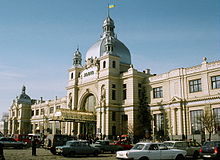 Lviv's Main Railway Terminal, an Art Nouveau style construction built in 1903 by Władysław Sadłowski.
Lviv's Main Railway Terminal, an Art Nouveau style construction built in 1903 by Władysław Sadłowski.
Modern Lviv remains a hub on which nine railways converge providing local and international services. Lviv railway is one of the oldest in Ukraine. The first train arrived to Lviv on 4 November 1861. The main Lviv Railway Station, designed by Władysław Sadłowski, was built in 1904 and was considered one of the best in Europe from both the architectural and the technical aspects.
In the interbellum period Lviv (known then as Lwów) was one of the most important hubs of the Polish State Railways. The junction at Lviv consisted in mid-1939 of four stations — main station Lwów Główny (now Ukrainian: Lviv Holovnyi), Lwów Kleparów (now Lviv Klepariv), Lwów Łyczaków (now Lviv Lychakiv), and Lwów Podzamcze (now Lviv Pidzamche). In August 1939 just before World War II 73 trains departed daily from the Main Station including 56 local and 17 fast trains. Lviv was directly connected with all major centers of the Second Polish Republic as well as such cities as Berlin, Bucharest, and Budapest.[72]
Currently several trains cross the nearby Polish–Ukrainian border (mostly via Przemyśl in Poland). There are good connections to Slovakia (Košice) and Hungary (Budapest). Many routes have overnight trains with sleeping compartments.
Lviv railway is often called a main gateway from Ukraine to Europe although buses are often a cheaper and more convenient way of entering the "Schengen" countries.
Air transport
Beginnings of aviation in Lviv reach back to 1884 when the Aeronautic Society was opened there. The Society issued its own magazine Astronauta but soon ceased to exist. In 1909 on the initiative of Edmund Libanski the Awiata Society was founded. Among its members there was a group of professors and students of the Lviv Polytechnic, including Stefan Drzewiecki and Zygmunt Sochacki. Awiata was the oldest Polish organization of this kind and it concentrated its activities mainly on exhibitions such as the First Aviation Exhibition which took place in 1910 and featured models of aircraft built by Lviv students.[73]
In 1913–1914 brothers Tadeusz and Władysław Floriańscy built a two-seated airplane. When World War I broke out Austrian authorities confiscated it but did not manage to evacuate the plane in time and it was seized by the Russians who used the plane for intelligence purposes. The Floriański brothers' plane was the first Polish-made aircraft. On 5 November 1918, a crew consisting of Stefan Bastyr and Janusz de Beaurain carried out the first ever flight under the Polish flag taking off from Lviv's Lewandówka (now Ukrainian: Levandivka) airport.[73] In the interbellum period Lviv was a major center of gliding with a notable Gliding School in Bezmiechowa which opened in 1932. In the same year the Institute of Gliding Technology was opened in Lviv and was the second such institute in the world. In 1938 the First Polish Aircraft Exhibition took place in the city.
Interbellum Lviv also was a major center of the Polish Air Force with the Sixth Air Regiment located there. The Regiment was based at the airport in Lviv's suburb of Skniłów (today Ukrainian: Sknyliv) opened in 1924. Sknyliv Airport is now named Lviv International Airport (LWO), and is located 6 km from the city centre.[74] A new terminal and other improvements are being under a $200 million expansion project in preparation for the 2012 UEFA European Football Championship.[74]
See also
- List of Leopolitans
- Polish football clubs started in Lviv: Pogoń Lwów, Czarni Lwów, Lechia Lwów, Hasmonea Lwów [75] Tilki u Lvovi by Yurko Hnatovski (music of Henryk Warszawski) (Ukrainian)
References
- ^ Lviv is the best city for living in Ukraine – rating, UNIAN (12 June 2009)
- ^ Iсторія Львова. У трьох томах / Я. Ісаєвич, М. Литвин, Ф. Стеблій. — Львів : Центр Європи, 2006. — Т. 1. — p7. — ISBN 978-966-7022-59-4 (Ukrainian: History of Lviv in Three Tomes")
- ^ Antoni Schneider, Badania i poszukiwania archeologiczne w Galicji w ostatnich latach, Przegląd Archeologiczny, R.1.: 1876, z.1, s. 16–22; Oleksij Onysymowyć Ratyć, Drevnorus'ki materiały z rozkopok 1955–56 rr. na Zamkovij hori u L'vovi, Materiały i Doslidżennja z Archeologii Prykarpatt'ja i Vołyni 1961, t. 3, s. 115–127 [in:] Łukasz Walczy, Początki Lwowa w świetle najnowszych badań [in:] Lwów wśród nas, cz. 2, 2006, s. 20–21
- ^ Vołodymyr Vujcyk, Derżavnyj Istoryczno-Architekturnyj Zapovidnyk u L'vovi. Lwów 1991 r. s. 9 [w:] Łukasz Walczy, Początki Lwowa w świetle najnowszych badań [in:] Lwów wśród nas, cz. 2, 2006, s. 20–21
- ^ Orest Subtelny. (1988) Ukraine: A History. Toronto: University of Toronto Press, p62
- ^ a b c d e f g h Meyers Konversations-Lexikon. 6th edition, vol. 12, Leipzig and Vienna 1908, p. 397-398.
- ^ Vasylʹ Mudryĭ, ed (1962). Naukove tovarystvo im. Shevchenka – Lviv: a symposium on its 700th anniversary. Shevchenko Scientific Society (U.S.). p. 58. http://books.google.co.uk/books?id=iT1pAAAAMAAJ&q=lviv+Burundai&dq=lviv+Burundai&hl=en&ei=O1ZATdnSF8aZhQfilIizCA&sa=X&oi=book_result&ct=result&resnum=1&ved=0CC8Q6AEwAA. Retrieved 29 January 2011. "on the occasion of the demand of the baskak of the Tatars, Burundai, that the prince Vasylko and Lev raze their cities said Buronda to Vasylko: 'Since you are at peace with me then raze all your castles'"
- ^ Basil Dmytryshyn (1991). Medieval Russia: a source book, 850-170. Holt, Rinehart and Winston. p. 173. ISBN 9780030334221. http://books.google.co.uk/books?id=WrtoAAAAMAAJ&q=lvov+Burundai&dq=lvov+Burundai&hl=en&ei=qVZATePjLsHPhAeUorGwCA&sa=X&oi=book_result&ct=result&resnum=3&ved=0CDoQ6AEwAg. Retrieved 29 January 2011.
- ^ a b Universal-Lexikon der Gegenwart und Vergangenheit (edited by H. A. Pierer). 2nd edition, vol. 17, Altenburg 1843, pp. 343–344.
 Works related to Universal-Lexikon_der_Gegenwart_und_Vergangenheit at Wikisource
Works related to Universal-Lexikon_der_Gegenwart_und_Vergangenheit at Wikisource - ^ B.V. Melnyk, Vulytsiamy starovynnoho Lvova, Vyd-vo "Svit" (Old Lviv Streets), 2001, ISBN 966-603-048-9
- ^ Allgemeine Enzyklopädie der Wissenschaft und Künste, edited by Johann Samuel Ersch and Johann Gottfried Gruber. Vol. 5, Leipzig 1820, p. 358, footnote 18) (in German).
- ^ Dobson, Richard Barrie; Walford, Michael Lapidge ; English translation by Adrian (2000). Andre Vauchez ; in conjunction with Barrie. ed. Encyclopedia of the Middle Ages. Chicago: Routledge. p. 879. ISBN 1579582826.
- ^ Jacob Caro: Geschichte Polens. Vol. 2, Gotha 1863, p. 286 (in German, online)
- ^ Cathal J. Nolan. Wars of the age of Louis XIV, 1650-1715: an encyclopedia of global warfare and civilization. ABC-CLIO. 2008. pp. 332, 368.
- ^ a b Tony Jaques. Dictionary of battles and sieges: a guide to 8,500 battles from antiquity through the twenty-first century, Vol. 3. Greenwood Publishing Group. 2007. pp. 608, 895, 951
- ^ Francis Ludwig Carsten. The new Cambridge modern history: The ascendancy of France, 1648-88. Cambridge University Press. 1961. p. 512.
- ^ Jerzy Lukowski, Hubert Zawadzki. A concise history of Poland. Cambridge University Press. 2001. p. 81. Cambridge University Press. 2001. p. 81.
- ^ Tertius Chandler. (1987) Four Thousand Years of Urban Growth: An Historical Census. Lewiston, New York: Edwin Mellon Press
- ^ a b New International Encyclopedia, Volume 13. Lemberg 1915, p. 760
- ^ Paul Robert Magocsi. (2005) Galicia: a Multicultured Land. Toronto: University of Toronto Press. pp.12–15
- ^ Timothy Snyder, The Reconstruction of Nations: Poland, Ukraine, Lithuania, Belarus, 1569–1999, Yale University Press, 2003, p.158
- ^ Norman Davies. "Ethnic Diversity in Twentieth Century Poland." In: Herbert Arthur Strauss. Hostages of Modernization: Studies on Modern Antisemitism, 1870-1933/39. Walter de Gruyter, 1993.
- ^ Norman Davies, White Eagle, Red Star. Polish-Soviet War
- ^ Леонид Соколов (9 December 1931). "Л.Соколов, Кто сделал Львов украинским городом? – Украинские Страницы". Ukrstor.com. http://ukrstor.com/ukrstor/sokolov_lvovua.html. Retrieved 25 January 2010–.
- ^ Mały Rocznik Statystyczny 1939 (Polish statistical yearbook of 1939), GUS, Warsaw, 1939
- ^ Text of the 1922 Bill (in Polish)
- ^ Magoscy, R. (1996). A History of Ukraine. Toronto: University of Toronto Press.
- ^ Subtelny, Orest (1988). Ukraine: A History. Toronto: University of Toronto Press.
- ^ Paul Robert Magocsi. (2005)Galicia: a Multicultured Land. Toronto: University of Toronto Press. pp.144–145
- ^ Robert M. Kennedy, The German Campaign In Poland (1939), Major Infantry United States Army DEPARTMENT OF THE ARMY DC 1956.
- ^ Ukraine: A Concise Encyclopedia, Volume I (1963). Edited by Volodymyr Kubiyovych. Toronto: University of Toronto Press. pp. 831–833 and pp.872–874
- ^ Paul Robert Magocsi. (1996). A History of Ukraine. Toronto: University of Toronto Press
- ^ Lviv massacre
- ^ Організація українських націоналістів і Українська повстанська армія. Інститут історії НАН України.2004р Організація українських націоналістів і Українська повстанська армія,
- ^ І.К. Патриляк. Військова діяльність ОУН(Б) у 1940—1942 роках. — Університет імені Шевченко \Ін-т історії України НАН України Київ, 2004 (No ISBN)
- ^ ОУН в 1941 році: документи: В 2-х ч Ін-т історії України НАН України К. 2006 ISBN 966-02-2535-0
- ^ Text of Polish-Soviet Treaty of 1941
- ^ ОУН і УПА в 1943 році: Документи / НАН України. Інститут історії України. – К.: Інститут історії України, 2008. – 347 с. ISBN 978-966-02-4911 p.166
- ^ United States Holocaust Memorial Museum[dead link]
- ^ the holocaust research project
- ^ The architecture of Poland: An historical survey by Zbigniew Dmochowski
- ^ [1] full text of the agreement (Polish)
- ^ Official site of the Khloptsi z Bandershtadtu
- ^ Tchorek, Kamil (26 November 2004). "Protest grows in western city". Times Online. http://www.timesonline.co.uk/tol/news/world/article395652.ece. Retrieved 25 July 2009.
- ^ a b c d According to the census of 2001
- ^ a b Heidemarie Petersen: Judengemeinde und Stadtgemeinde in Polen: Lemberg 1356–1581. Harrasso Verlagm Wiesbaden 2003, p. 50 (in German, limited online preview)
- ^ Universal-Lexikon der Gegenwart und Vergangenheit (edited by H. A. Pierer). 2nd edition, vol. 7, Altenburg 1843, p. 344.
- ^ Konversations-Lexikon (edited by Brockhaus). 10th edition, vol. 9, Leipzig 1853, p. 512.
- ^ Brockhaus' Konversations-Lexikon. 14th edition, vol. 11, Leipzig 1894, p. 76
- ^ Meyers Konversations-Lexikon. 6th edition, vol. 12, Leipzig and Vienna 1908, pp. 397–398.
- ^ a b Der Große Brockhaus. 15th edition, vol. 11, Leipig 1932, pp. 296–297.
- ^ Meyers Enzyklopädisches Lexikon. 9th edition, vol. 14, Mannheim/Vienna/Zürich 1975, p. 802.
- ^ a b c Ethnic groups in Lviv, 2001 Ukrainian Census
- ^ Yaroslav Hrytsak. (2005). Historical Memory and Regional Identity. In Galicia: A Multicultured Land. Christopher Hann and Paul Robert Magocsi (Eds.) Toronto: University of Toronto Press. pp. 185–209
- ^ 1.2% of 790,908
- ^ (Russian) Всесоюзная перепись населения 1989 г.
- ^ a b c d R. Lozinsky. "poles in Lviv". http://postup.brama.com/010928/148_8_1.html.
- ^ a b Polish Embassy The Poles in Lviv continue to be proud of their identity[dead link], accessed 21:05, 29 October 2009
- ^ Heidemarie Petersen: Judengemeinde und Stadtgemeinde in Polen: Lemberg 1356–1581 (= Forschungen zur osteuropäischen Geschichte, Vol. 61, edited by Osteuropa-Institut of the Free University of Berlin). Harrassowitz Verlag, Wiesbadeb 2003, p. 37 ff. (in German, limited online preview)
- ^ L'viv – the Ensemble of the Historic Centre, UNESCO — World Heritage. URL Accessed: 30 October 2006
- ^ Ukrainian Center for Holocaust Studies | Lviv
- ^ Stanislaw M. Ulam, Adventures of a Mathematician, New York: Charles Scribner's Sons, 1976. ISBN 0-684-15064-6
- ^ "The Scottish Café in Lvov", at the MacTutor History of Mathematics archive.
- ^ Slowo Polskie – a daily with 100-year tradition
- ^ "Lviv – the chess capital of Ukraine".
- ^ "Jewish Russian Telegraph: Faina Kirshenbaum, Israel's Ambassador to Ukraine". Jrtelegraph.com. 2010-07-18. http://www.jrtelegraph.com/2010/07/faina-kirshenbaum-israels-ambassador-to-ukraine.html. Retrieved 2011-06-01.
- ^ "Serwis informacyjny UM Rzeszów – Informacja o współpracy Rzeszowa z miastami partnerskimi". www.rzeszow.pl. http://www.rzeszow.pl/wspolpraca-miedzynarodowa/informacja-o-wspolpracy-rzeszowa-z-miastami-partnerskimi/668,informacja-o-wsp-lpracy-rzeszowa-z-miastami-partnerskimi.html. Retrieved 2 February 2010.[dead link]
- ^ "Kraków otwarty na świat". www.krakow.pl. http://www.krakow.pl/otwarty_na_swiat/?LANG=UK&MENU=l&TYPE=ART&ART_ID=16. Retrieved 19 July 2009.
- ^ "Wrocław Official Website — Partnership Cities of Wrocław". http://www.wroclaw.pl/p/964/. Retrieved 23 October 2008. (Polish)
- ^ "World Airline Directory." Flight International. 27 March-2 April 2001. 102. 102.
- ^ Lviv dialect
- ^ Urzędowy Rozkład Jazdy i Lotów PKP, Lato 1939 (Polish State Railroads Timetable, Summer 1939)
- ^ a b Zdzislaw Sikorski, Lotniczy Lwow
- ^ a b Europe Airports – Lviv (LWO)
- ^ Jakob Weiss, The Lemberg Mosaic (New York: Alderbrook Press, 2011) pp. 72 – 76.
External links
Lviv travel guide from Wikitravel
- city-adm.lviv.ua — Official Lviv city council website (Ukrainian)
- www.lvivcenter.org — Multilingual Website of the Center for Urban History in Lviv
- www.lviv-online.com Lviv Online. The city events guide
- Ukrainian Navigational Portal – Photos and infrastructure objects of Lviv on interactive map
- Lviv Map — Download and print
- Lviv Rail Terminal — Official website
- FC Karpaty Lviv — Official website
- [2] Lviv – photographs and information in Czech
- Lviv tramway
- “Lviv Reminiscences”, Olena Krushynska’s photogallery (Ukrainian, English, Italian)
- Lviv in Photos
- www.lwow.eu — many photos, articles & informations about city and its history (Polish)
- Lviv Market Square- Details of the market square
- 180° High Definition Panorama of Lviv — Gives a panorama view of the entire city at telescopic resolution
Armenian Statute · Dormition Brotherhood · Jesuit Collegium · First Siege by Cossacks · Second Siege by Cossacks · Lwów Oath · Siege by Turks · Leopolis Triplex · Stauropegion Institute · Stauropegion Press · Ossolineum · Galician Rada · Halytsko-Ruska Matytsia · Prosvita · Ruthenian Triad · Ruthenian National House · Hutsul Secession · Batiars · Lwów Eaglets · Battle 1918 · Pogrom 1918 · Battle 1920 · Secret Ukrainian University · School of Logic · School of Mathematics · Battle 1939 · Massacre of Lviv professors · Lviv pogroms · Lemberg Ghetto · Lwów Uprising · Sknyliv airshow disaster
Religion Armenian Cathedral · Cathedral of St. George · Chapel of the Boim family · Bernardine Church · Bridgettine Convent · Carmelite Church · Convent of Benedictines · Church of St. Anne · Church of John the Baptist · Church of Mary of Snow · Church of St. Elizabeth · Church of St. Mary Magdalene · Church of St. Onuphrius · Church of the Dormition · Church of the Purification, Lviv · Church of the Transfiguration · Dominican Church · Jesuit Church · Latin Cathedral
Attractions Arena Lviv · Arsenal Museum · Bandinelli Palace · Black Kamienica · Catholic University · Cemetery of the Defenders of Lwów · Freedom Boulevard · Government House · King Cross Leopolis · Korniakt Palace · Lviv High Castle · Lviv University · Lychakivskiy Cemetery · Market Square · Mickiewicz Square · National Museum · Polytechnic University · Liubomyrsky Palace · Metropolitan Palace · Old Town · Pharmacy Museum · Pototsky Palace · Sapieha Palace · Scottish Café · Shevchenkivskyi Hai · Theatre of Opera and Ballet · Town Hall · Ukraina Stadium · Union of Lublin Mound
Transport Administrative divisions of Lviv Oblast, Ukraine Raions 

Cities Belz · Bibrka · Boryslav · Brody · Busk · Chervonohrad · Dobromyl · Drohobych · Dubliany · Hlyniany · Horodok · Kamianka-Buzka · Khodoriv · Khyriv · Komarno · Lviv · Morshyn · Mostyska · Mykolaiv · Novoiavorivsk · Novyi Kalyniv · Novyi Rozdil · Peremyshliany · Pustomyty · Radekhiv · Rava-Ruska · Rudky · Sambir · Skole · Sokal · Sosnivka · Staryi Sambir · Stebnyk · Stryi · Sudova Vyshnia · Truskavets · Turka · Uhniv · Velyki Mosty · Vynnyky · Yavoriv · Zhovkva · Zhydachiv · ZolochivUrban-type
settlementsVillages  Administrative divisions of Ukraine
Administrative divisions of UkraineOblasts Cherkasy · Chernihiv · Chernivtsi · Dnipropetrovsk · Donetsk · Ivano-Frankivsk · Kharkiv · Kherson · Khmelnytskyi · Kiev · Kirovohrad · Luhansk · Lviv · Mykolaiv · Odessa · Poltava · Rivne · Sumy · Ternopil · Vinnytsia · Volyn · Zakarpattia · Zaporizhia · ZhytomyrCities with special status Autonomous Republic Administrative centers Cherkasy · Chernihiv · Chernivtsi · Dnipropetrovsk · Donetsk · Ivano-Frankivsk · Kharkiv · Kherson · Khmelnytskyi · Kiev · Kirovohrad · Luhansk · Lutsk · Lviv · Mykolaiv · Odessa · Poltava · Rivne · Sevastopol · Simferopol · Sumy · Ternopil · Uzhhorod · Vinnytsia · Zaporizhia · ZhytomyrKiev: Saint-Sophia Cathedral and Related Monastic Buildings / Kiev Pechersk Lavra · L'viv - the Ensemble of the Historic Centre · Chernivtsi - the Residence of Bukovinian and Dalmatian Metropolitans · Struve Geodetic Arc (with nine other countries) · Primeval Beech Forests of the Carpathians (with Slovakia)
Historical Capitals of Rus' and other Ukrainian states Medieval Ukrainian statesKievan Rus' Kingdom of Galicia–Volhynia Cossack Hetmanate Grand Duchy of Rus' West Ukrainian People's Republic Ukrainian People's Republic Ukrainian Soviet Republic (ru) Donetsk-Krivoy Rog Soviet Republic Ukrainian SSR (part of the SU 1922-91), Ukraine Footnotes: Categories:- World Heritage Sites in Ukraine
- Lviv
- Lviv Oblast
- Cities in Ukraine
- Historic Jewish communities
- History of Poland
- Populated places established in the 13th century
- Recipients of the Virtuti Militari
Wikimedia Foundation. 2010.

